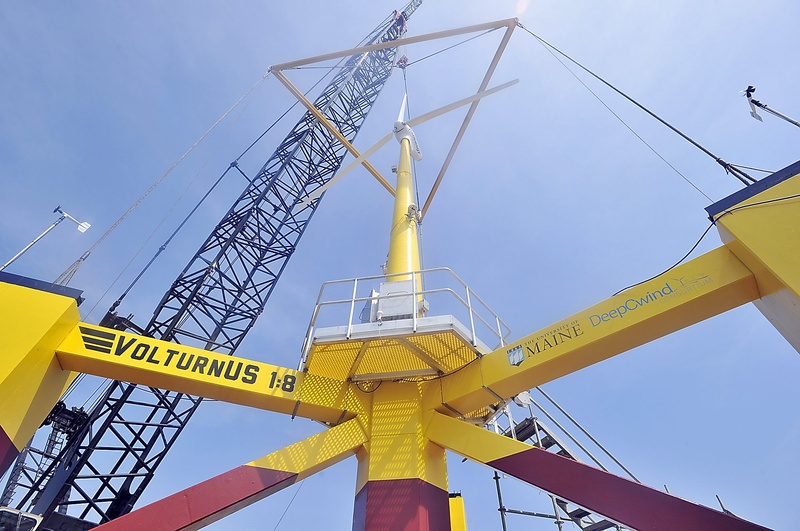A wide-ranging energy bill that won broad support in the Legislature could be vetoed Wednesday by Gov. Paul LePage if an amendment to help the University of Maine’s offshore floating wind project isn’t included in the law, the governor’s energy director said Tuesday.
At issue is the governor’s desire to support the university’s VolturnUS pilot project over a competing venture being developed by Statoil USA, the Norwegian energy company.
LePage is unhappy with the terms of a contract and the above-market power rate for Statoil that was approved last winter by the Maine Public Utilities Commission. The governor wants to create a new process at the PUC by which both projects could be evaluated, to weigh their benefits to ratepayers, according to the energy director, Patrick Woodcock. The idea is to assure that ratepayers are getting the best deal, Woodcock said, before a final contract is signed with Statoil and the PUC this summer.
The energy bill was passed by the Legislature earlier this month by wide margins in both the House and Senate. LePage has until midnight Wednesday to veto the bill or let it become law without his signature. If the governor rejects the bill, it would take a two-thirds vote in the Legislature to override the veto.
One of the bill’s co-sponsors said he would be trying hard to find common ground with LePage and avert a veto. Sen. John Cleveland, D-Auburn, said failure to pass the bill would leave the state unable to negotiate for new natural gas capacity and lower wholesale prices, for instance, a shortcoming that’s costing Maine homes and businesses $200 million a year.
“It would be extremely unfortunate and do great economic harm to the state of Maine,” Cleveland said.
Responding to the governor’s position, Statoil’s project manager for Maine said the company had responded in good faith to the state’s request for investment to develop offshore wind energy, and based on approvals from the PUC, had made “significant investments” in the project.
“We have been collaborating for more than three years with the University of Maine,” said Kristin Aamodt in an email from Norway, “and an R&D program with the university is part of the Hywind Maine project going forward.”
Aamodt noted that Statoil had committed to using Maine companies as much as possible to build a commercial-scale wind park.
“We believe this project will be important for establishing an offshore wind industry in Maine,” she said.
The bill’s initial passage was hailed as a bipartisan victory by lawmakers, in a session marked by much conflict and tension between the two parties. It promised to help lower energy costs for Mainers by expanding natural gas pipelines in the region, increasing funding for energy-efficiency programs and helping residents switch to more-affordable heating systems.
Those goals now may be at risk, as well as the state’s ability to attract energy-related business investment, according to Paul Williamson, executive director of the Maine Ocean and Wind Industry Initiative.
Maine passed an Ocean Energy Act with the hope of making the state a center of offshore energy research and development. Statoil responded to a request for proposals and was picked for its Hywind Maine pilot project two years ago by the PUC. It later had its terms approved. UMaine’s project wasn’t far enough along at the time and didn’t submit a proposal, Williamson said.
“It’s a really bad position for the state of Maine,” he said. “We’ve negotiated an agreement with a multinational firm that could invest millions of dollars here. Once you’ve set the rules of the game, and everyone agrees with them, you have to move forward.”
Last month, the university launched its one-eight scale model into the Penobscot River, for testing off Castine and Monhegan Island. If the concrete and composite technology is proven, the next step is to build two six-megawatt turbines that could generate enough power for 6,000 homes.
Statoil, meanwhile, is planning four three-megawatt turbines off Boothbay Harbor. It’s conducting tests this summer. It already has built and tested a full-scale, floating steel turbine off Norway.
Because the two projects are in different phases, it’s hard for state government to compare the technologies and decide which is better, Williamson said.
Both projects, however, are competing for a new round of federal grant money, which could be crucial for each to move ahead. Each has to show the Department of Energy that its technology is affordable and will generate power at market rates in 2020.
Whether or not LePage chooses to veto the energy bill, his actions are sending a disturbing message to international investors, according to Jeremy Payne, executive director of the Maine Renewable Energy Association.
“The reality is, Statoil is trying to invest here, and we shouldn’t create a reason for them not to do that,” he said.
He also said LePage is being contradictory when he criticizes Statoil’s power contract but then seeks special favors for UMaine. The state’s Ocean Energy Act recognized that power from small, pilot projects would be more expensive.
“When a term sheet is signed, it ought to be honored,” he said.
But Woodcock said a term sheet isn’t the same as a signed contract.
“Any business knows a deal isn’t done until there’s a final contract,” he said.
Woodcock said a review of the two projects would help determine which could be developed at the lower prices. The added competition would improve such an important project, he said, pledging that the review process would be done as quickly as possible.
Tux Turkel can be contacted at 791-6462 or at:
tturkel@mainetoday.com
Send questions/comments to the editors.




Comments are no longer available on this story